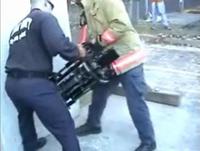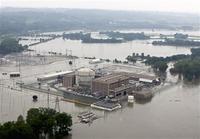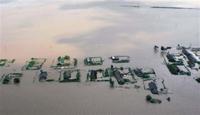-
Understanding deadly tornadoes

Scientists at the University of Alabama in Huntsville (UAH) are analyzing radar data from 27 April 2011 — the day that saw of the deadliest tornado outbreaks in U.S. history — then merging the information with detailed storm surveys and other data; they hope to learn more about how the storms formed, what made the storms so powerful and what might be done to make tornado warnings more effective
-
-
Volunteers help California build quake sensor network
Thousands of residents across California are helping the U.S Geological Survey (USGS) build a dense network of seismic sensors across the state; as part of the Quake Catcher Network, Californians are being asked to place 6,000 seismic sensors in their homes to help geologists study earthquakes
-
-
Louisiana parish plans extreme weather alert system
Emergency officials in Ouachita Parish, Louisiana are considering installing warning sirens that would alert residents of dangerous weather; officials hope to install sixty towers throughout the Parish; authorities are currently conducting feasibility studies to determine if installing the sirens is practical and a financial possibility
-
-
Trapped couple receives bill for stay in New Zealand hotel during quake
A couple stuck in a Christchurch, New Zealand hotel after the 22 February 6.3 magnitude earthquake struck the city, was shocked to discover they had been charged for their stay; a New Zealand man and his wife were trapped on the hotel’s twenty-second floor for hours and eventually were forced to escape after daringly crossing collapsed stair cases, smashing down doors, and crawling to the roof of a parking lot nearby
-
-
45 percent of children in Fukushima exposed to thyroid radiation

A survey revealed that 45 percent of children living near the Fukushima Daiichi nuclear power plant have been exposed to thyroid radiation; following the nuclear disaster and the revelation that radiation was leaking from reactor no. 1, researchers tested more than 1,000 children from newborns to age fifteen in the Fukushima Prefecture; children were found to have been exposed to 0.04 microsievert per hour or less in most cases
-
-
Key to coping with disasters: neighbors
A political scientist who had moved to New Orleans only weeks before Hurricane Katrina concluded that neighbors — and cooperation among neighbors — are more important for surviving, coping with, and recovering from disasters than ambulances and fire trucks and government aid; to make sure his observations were more than anecdotal, he visited disaster areas around the world, and his data show that his personal experiences reflect a larger truth
-
-
Disasters hit businesses hard, keeping many permanently closed
Business owners across the United States are being urged to create emergency plans, so that they can continue operating in the wake of a natural disaster; according to the Insurance Institute for Business and Home Safety, 25 percent of businesses hit by a natural disaster are unable to continue functioning
-
-
Missouri struggles to pay for natural disasters
Last week, Missouri governor Jay Nixon ordered his state budget director to put aside an additional $100 million to help the state’s disaster stricken areas recover; Governor Nixon has already ordered $50 million to be withheld, but Linda Luebbering, the state budget director, worries that the $150 million is not enough
-
-
Quake-resistant superelastic alloy developed
Japanese scientists added a small amount of nickel to an iron-based alloy, and found that the new material can recover its original shape at any temperature from -196 to 240 degrees Celsius; the material may be used in environments that are constantly exposed to extreme temperatures, such as joints and controls in cars, planes, and spacecraft; it may also help buildings cushion stress and violent movement in earthquakes
-
-
Los Alamos nuclear waste safe from wildfire
A wildfire is raging near the Los Alamos national Lab; the fire, in some places, is only yards away from the lab’s outside perimeter — and it is eight miles from the so-called Area G; the Area G site is a 63-acre storage facility where thousands of drums of nuclear waste sit, many of which are outdoors started; the good news is that there is no danger that the fire will reach Area G because in 2000, an even more intense fire burned 90 percent of the forest that covered the area between the current fire and the nuclear waste disposal site, making it impossible for the current wild fire to reach the nuclear material on storage
-
-
Concrete-breaching rescue tool available via GSA schedule

Raytheon’s Controlled Impact Rescue Tool (CIRT) is a portable unit designed to aid fire departments, local and federal rescue agencies, and the military services; the tool sends pulverizing shock waves that enable rescuers to breach concrete structures faster than with existing techniques such as drilling, chipping or sawing; GSA has just added CIRT to the GSA schedule
-
-
Nebraska floods test a nuclear power plants new safety measures

U.S. nuclear officials are closely monitoring two atomic energy plants in Nebraska that are in danger of being inundated with water as the Missouri River continues to creep ever closer; the Fort Calhoun nuclear plant has been closed for refueling since April and will remain off until the flooding subsides, but officials are worried about keeping the recently removed fuel rods cool as the facility’s parking lot has been flooded
-
-
Oh my, the trouble with evacuating lions, tigers, and bears

Rescuing and housing the many exotic animals at Minot, North Dakota’s Roosevelt Park Zoo from record floods presented zoo workers with a unique challenge; it was no small feat finding vehicles large enough for giraffes or getting dangerous animals like bears and wolves to cooperate; currently more than 100 animals are housed in an old furniture warehouse; makeshift pens hold deer, emu, warthogs, bobcats, monkeys and chickens, while workers struggle to keep the animals comfortable
-
-
Severe flooding in China destroys crops, food prices soar

China’s beleaguered farmers were dealt another blow as devastating floods inundated much of the country’s east, south, and southwest; the water has caused more than $5 billion in damage, displaced more than 1.6 million people, and killed at least 175 people; the floods have destroyed large portions of crops and will reduce vegetable yields by an estimated 20 percent in some areas; more than one million acres of crops have been destroyed across the country pushing grain and vegetable prices higher
-
-
Weather variations cost U.S. $485 billion a year

New research finds that routine weather events such as rain and cooler-than-average days can add up to an annual economic impact of as much as $485 billion in the United States; the study found that finance, manufacturing, agriculture, and every other sector of the economy is sensitive to changes in the weather, and that the impact of routine weather variations on the economy is as much as 3.4 percent of U.S. gross domestic product
-
More headlines
The long view
The Surprising Reasons Floods and Other Disasters Are Deadlier at Night
By Kate Yoder
It’s not just that it’s dark and people are asleep. Urban sprawl, confirmation bias, and other factors can play a role.
Why Flash Flood Warnings Will Continue to Go Unheeded
By Rebecca Egan McCarthy
Experts say local education and community support are key to conveying risk.
